【java框架】MyBatis(7)--MyBatis注解开发
1.MyBatis注解开发
1.1.Lombok的基本使用
Lombok是SpringBoot2.1.X版本与IDEA官方支持的一个插件,它是为简化POJO类中繁杂重复代码:geter/setter/toString/hashcode/equals等,提供了一种
全注解的方式来简化我们日常项目中的代码,如今在SpringBoot与微服务项目中,Lombok是一款非常流行的插件,使用了解它可以提高我们日常的开发效率。
Lombok的使用非常简单:
①首先需要在IDEA的Settings-Plugins中去下载并安装Lombok的应用插件:

②在Maven项目中引入Lombok的依赖包:
<dependency>
<groupId>org.projectlombok</groupId>
<artifactId>lombok</artifactId>
<version>1.16.18</version>
<scope>provided</scope>
</dependency>
Lombok的scope=provided,说明它只在编译阶段生效,不需要打入包中。事实正是如此,Lombok在编译期将带Lombok注解的Java文件正确编译为完整的Class文件。
③在IDEA中设置开启对Lombok的注解Anno支持:
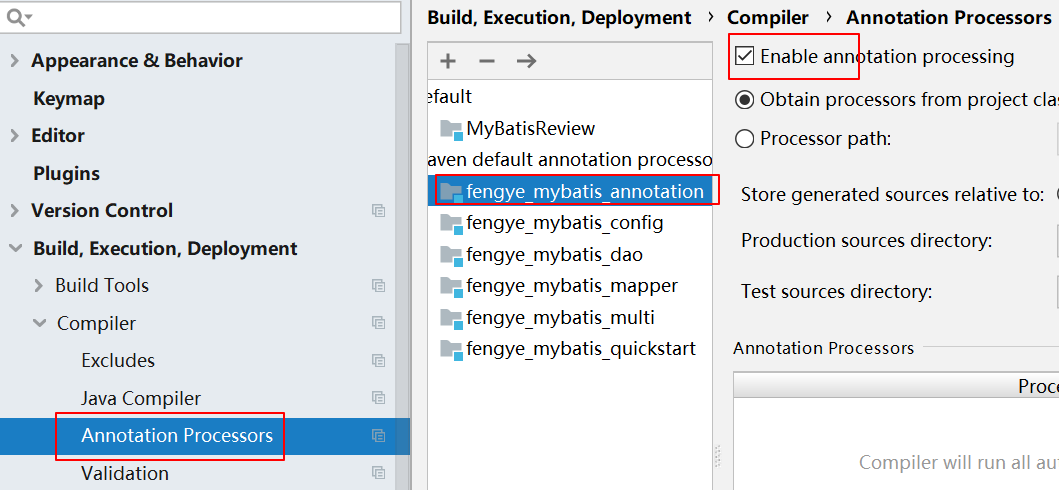
开启该项是为了让Lombok注解在编译阶段起到作用。
④在项目中的POJO类中使用Lombok的注解开发:
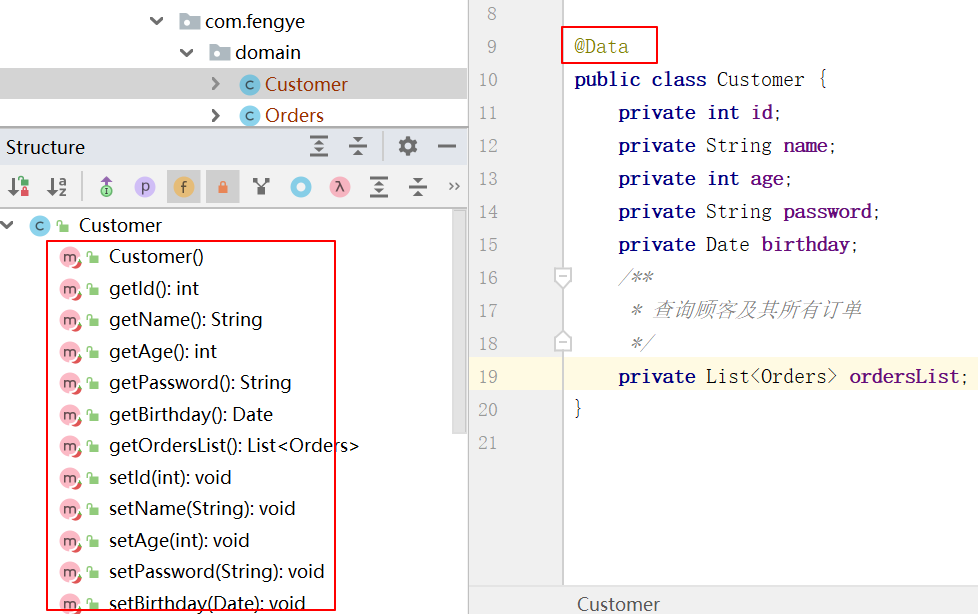
日常项目中比较常用的高频率注解:
- @Data:作用于类上,是以下注解的集合:@ToString @EqualsAndHashCode @Getter @Setter @RequiredArgsConstructor;
- @NoArgsConstructor:生成无参构造器;
- @AllArgsConstructor:生成全参构造器;
- @Log:作用于类上,生成日志变量。针对不同的日志实现产品,有不同的注解
1.2.Mybatis常用注解
- @Select:实现查询
- @Insert:实现插入
- @Update:实现更新
- @Delete:实现删除
- @Result:实现结果集封装
- @Results:可以与@Result连用,封装多个结果集
- @One:一对一关系结果封装
- @Many:多对一、多对多结果封装
1.3.简单增删改查
非常简单,直接上Mapper注解查询:
public interface CustomerMapper {
@Select("select id, name, age, password, birthday from customer")
List<Customer> selectCustomers();
@Insert("insert into customer values (#{id}, #{name}, #{age}, #{password}, #{birthday})")
int insert(Customer customer);
@Update("update customer set name = #{name}, password = #{password} where id = #{id}")
int update(Customer customer);
@Delete("delete from customer where id = #{id}")
int delete(int id);
@Select("select * from customer where id = #{id}")
Customer findOneById(int id);
}
需要注意的是需要在mybatis-config.xml配置文件中添加对应Mapper所在的类配置:
<mappers>
<mapper class="com.fengye.mapper.CustomerMapper"></mapper>
</mappers>
1.4.一对一关联查询
表关系模型:
顾客与订单号的关系:一个顾客对应多个订单,一个订单从属于一个顾客。
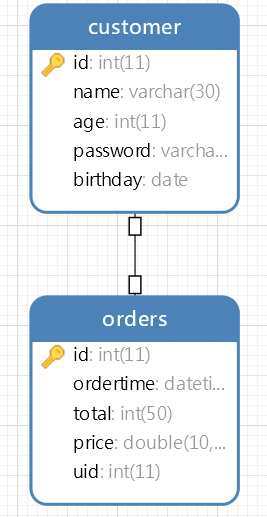
设计查询思路:从一方出发,查询商品订单同时,根据当前的uid查询出当前订单对应的顾客。
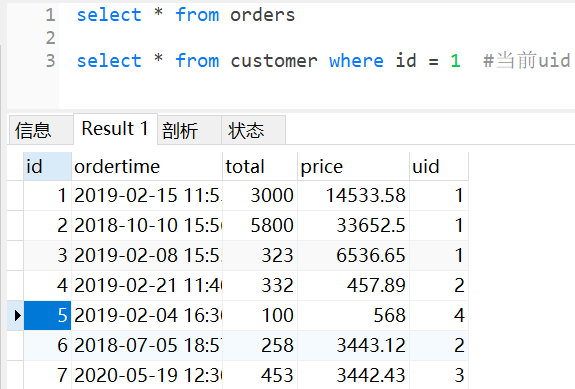
对应Mapper接口及相应配置:
public interface OrderMapper {
/**
* 一对一:订单对应一个客户
* @return
*/
@Select("select * from orders")
@Results(value = {
@Result(column = "id", property = "id", id = true),
@Result(column = "ordertime", property = "orderTime"),
@Result(column = "total", property = "total"),
@Result(column = "price", property = "price"),
@Result(property = "customer", one = @One(select = "com.fengye.mapper.CustomerMapper.findOneById"), column = "uid")
})
List<Orders> selectAll();
@Select("select * from orders where uid = #{uid}")
List<Orders> findByUid(@Param("uid") int id);
}
public interface CustomerMapper {
@Select("select * from customer where id = #{id}")
Customer findOneById(int id);
}
因为使用到了两个Mapper接口中的方法,所以需要引入对应的两个Mapper接口类:
<mappers>
<mapper class="com.fengye.mapper.CustomerMapper"></mapper>
<mapper class="com.fengye.mapper.OrderMapper"></mapper>
</mappers>
1.5.一对多关联查询
相反,对应一个顾客的订单可能是多个,那么从顾客角度分析,顾客与订单的关系就是一对多关系。
相应的查询设计思路:
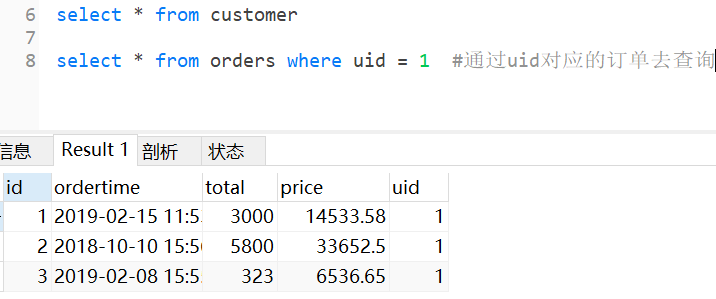
封装对应的Mapper注解查询接口如下:
public interface CustomerMapper {
@Select("select * from customer")
@Results({
@Result(property = "id", column = "id", id = true),
@Result(property = "name", column = "name"),
@Result(property = "age", column = "age"),
@Result(property = "password", column = "password"),
@Result(property = "birthday", column = "birthday"),
@Result(property = "ordersList", many = @Many(select = "com.fengye.mapper.OrderMapper.findByUid"),
column = "id", javaType = List.class)
})
List<Customer> selectAllList();
}
public interface OrderMapper {
@Select("select * from orders where uid = #{uid}")
List<Orders> findByUid(@Param("uid") int id);
}
1.6.多对多关联查询
多对多最经典的还是用户与角色的关系,一个用户对应多个角色,一个角色可以对应多个用户。
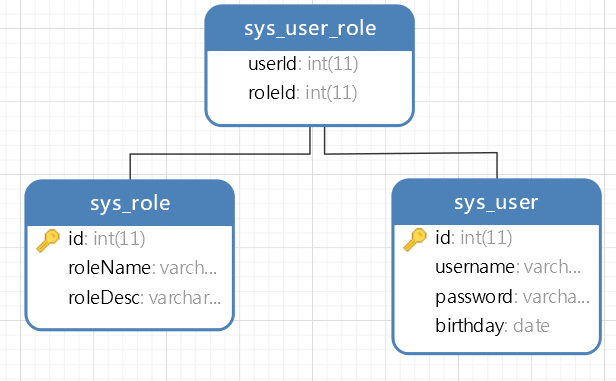
查询设计思路:
可以从角色入手,也可以从用户入手,在设计POJO时对应在多方肯定有一个集合的属性字段,假设从用户角度出发,设计查询语句如下:

对应的Mapper接口层注解封装如下:
public interface UserMapper {
/**
* 查询出所有用户及其对应的角色
* @return
*/
@Select("select * from sys_user")
@Results({
@Result(property = "id", column = "id", id = true),
@Result(property = "username", column = "username"),
@Result(property = "password", column = "password"),
@Result(property = "birthday", column = "birthday"),
@Result(property = "roleList", many = @Many(select = "com.fengye.mapper.RoleMapper.findRoleListByUid"),
column = "id", javaType = List.class)
})
List<User> findAllUserRole();
}
public interface RoleMapper {
@Select("select * from sys_role r, sys_user_role ur where r.id = ur.roleId and ur.userId = #{uid}")
List<Role> findRoleListByUid(@Param("uid") int uid);
}
注解开发优缺点:
注解开发相对于传统的xml可以在实际项目中一定程度的减少大量的xml配置,针对于基础简单的sql语句非常实用;
但是注解开发并不能完全替代xml,比如动态sql使用<if>条件查询等复杂sql的场景,最好还是使用xml。
本博客写作参考文档:
https://www.jianshu.com/p/2543c71a8e45 《Lombok的基本使用》
https://www.bilibili.com/video/BV1XV411e7hm?p=30 《Mybatis注解开发》
示例代码已上传至Github地址:
https://github.com/devyf/MyBatisReview/tree/master/fengye_mybatis_annotation
【java框架】MyBatis(7)--MyBatis注解开发的更多相关文章
- MyBatis:使用注解开发
面向接口编程 大家之前都学过面向对象编程,也学习过接口,但在真正的开发中,很多时候我们会选择面向接口编程 根本原因 : 解耦 , 可拓展 , 提高复用 , 分层开发中 , 上层不用管具体的实现 , 大 ...
- 8、MyBatis之使用注解开发
9.使用注解开发 mybatis最初配置信息是基于 XML ,映射语句(SQL)也是定义在 XML 中的.而到MyBatis 3提供了新的基于注解的配置.不幸的是,Java 注解的的表达力和灵活性十分 ...
- mybatis学习——使用注解开发
前言: 一个语句既可以通过 XML 定义,也可以通过注解定义.不过,由于 Java 注解的一些限制以及某些 MyBatis 映射的复杂性,要使用大多数高级映射(比如:嵌套联合映射),仍然需要使用 XM ...
- Mybatis学习笔记-注解开发
面向接口编程 根本原因:[解耦],[可拓展],[更高规范性] 接口类型: abstract class interface 使用注解开发 简单语句可用注解开发(直接查询,列名与属性名相同) 本质:反射 ...
- java框架之Spring(2)-注解配置IOC&AOP配置
注解配置IoC 准备 1.要使用注解方式配置 IoC,除了之前引入的基础 jar 包,还需要引入 spring-aop 支持包,如下: 2.在 applicationContext.xml 中引入 c ...
- Mybatis之使用注解开发CRUD
上一篇演示了怎样使用XML来操作Mybatis实现CRUD,可是大量的XML配置文件的编写是很烦人的.因此 Mybatis也提供了基于注解的配置方式,以下我们来演示一下使用接口加注解来实现CRUD的的 ...
- JAVA框架 Spring 和Mybatis整合(传统dao)
一:我们使用spring处理service,mybaits处理dao层. 二:导入jar包 pom.xml文件内容: <?xml version="1.0" encoding ...
- java框架之Spring(5)-注解驱动开发
准备 1.使用 maven 创建一个 java 项目,依赖如下: <dependency> <groupId>org.springframework</groupId&g ...
- JAVA框架 Spring 和Mybatis整合(动态代理)
一.使用传统方式的dao的书写方式,不建议.目前采用的是动态代理的方式交给mybatis进行处理. 首先回顾下动态代理要求: 1)子配置文件的中,namespace需要是接口的全路径,id是接口的方法 ...
- (七)Mybatis总结之注解开发
请移步到 https://www.cnblogs.com/lxnlxn/p/5996707.html
随机推荐
- K8S(04)核心插件-coredns服务
K8S核心插件-coredns服务 目录 K8S核心插件-coredns服务 1 coredns用途 1.1 为什么需要服务发现 2 coredns的部署 2.1 获取coredns的docker镜像 ...
- HDU 6623 Minimal Power of Prime(思维)题解
题意: 已知任意大于\(1\)的整数\(a = p_1^{q_1}p_2^{q_2} \cdots p_k^{q_k}\),现给出\(a \in [2,1e18]\),求\(min\{q_i\},q ...
- 全球最好 css3 website
http://www.awwwards.com/ http://www.revolution.pn/ http://www.bestcss.in/ http://www.csswinner.com/ ...
- MongoDB Up and Going
# MongoDB Up and Going https://ide.c9.io/xgqfrms/mongodb # MongoDB 教程 https://www.runoob.com/mongodb ...
- mobile css & rem & em & px
mobile css & rem & em & px 1 rem === 16px 任意浏览器的默认字体高都是 16px, 所有未经调整的浏览器都符合: 1em=16px, 那 ...
- nvm install node error
nvm install node error ➜ mini-program-all git:(master) nvm install 10.15.3 Downloading and installin ...
- 多种转弯角度的PBN旁切转弯图例分析
无论世界怎样变化,我们依然是有点阳光就灿烂.面对世界的未知,最好的状态是勇敢的去面对,努力的去生活. 今天我们继续来聊一下PBN旁切转弯. PBN转弯保护区的结构通常都与它们的转弯角度大小有关,转弯角 ...
- linux DRM 之 GEM 笔记
原文链接:https://www.cnblogs.com/yaongtime/p/14418357.html 在GPU上的各类操作中涉及到多种.多个buffer的使用. 通常我们GPU是通过图像API ...
- Java的super、this、重写
Java的super.this.重写 一.super的注意点: super调用父类的构造方法,必须在构造方法的第一个: super只能出现在子类的构造方法或者方法中: this和super不能同时调用 ...
- 线上CPU飙升100%问题排查
本文转载自线上CPU飙升100%问题排查 引子 对于互联网公司,线上CPU飙升的问题很常见(例如某个活动开始,流量突然飙升时),按照本文的步骤排查,基本1分钟即可搞定!特此整理排查方法一篇,供大家参考 ...
